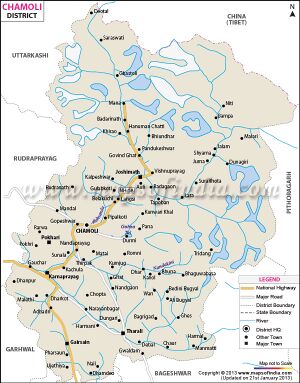Joshimath
| Author:Laxman Burdak, IFS (R) |

Joshimath (जोशीमठ) is a city in Chamoli District in the Indian state of Uttarakhand. It is home to one of the four cardinal pīthas established by Adi Shankara.
Location
Located at a height of 6150 feet it is gateway to several Himalayan mountain climbing expeditions, trekking trails and pilgrim centres like Badrinath.[1]
Variants
- Joshimatha जोशीमठ = ज्योतिर्मठ (जिला गढ़वाल) (AS, p.373)
- Jyotirmath/Jyotirmatha ज्योतिर्मठ = जोशीमठ (AS, p.377)
History
Between 7th and 11th centuries C.E., Katyuri kings, who were originally from Joshimath, ruled the area of varying extent from their capital at "Katyur" (modern day Baijnath) valley in Kumaon. The Katyuri dynasty was founded by Vashudev Katyuri, ancient Basdeo temple at Joshimath is attributed to Vasu Dev. Vasu Dev was of Buddhist origin, but later followed Brahmanical practices and the brahminical practices of Katyuri kings in general is sometimes attributed to a vigorous campaign of Adi Shankara (788-820 CE). Katyuri kings were displaced by the Chand Kings in the 11th century AD.[2]
जोशीमठ
विजयेन्द्र कुमार माथुर[3] ने लेख किया है ...जोशीमठ या 'ज्योतिर्मठ' (AS, p.373) टिहरी गढ़वाल ज़िला, उत्तराखंड में स्थित है। यह बदरीनाथ के 19 मील (लगभग 30.4 कि.मी.) नीचे प्राचीन तीर्थ स्थान है, जहाँ शंकराचार्य का मठ है। [p.374]: इसे ज्योतिर्लिंग का स्थान माना जाता है। जोशीमठ में मध्य काल में गढ़वाल के कत्यूरी नरेशों की राजधानी थी।यहाँ क़स्बे में वासुदेव का अति प्राचीन मंदिर है, जिसकी मूर्ति सुघड़ और सुंदर है। एक दूसरा मंदिर नरसिंह भगवान का है। मूर्ति आकार में छोटी है, किंतु चमत्कारपूर्ण समझी जाती है। मन्दिर के पास ही शंकराचार्य के निवास स्थान की गुफ़ा है और वह 'कीमू' (शहतूत) वृक्ष भी, जहाँ किंवदंती के अनुसार बैठकर शंकराचार्य ने महान् ग्रंथों की रचना की थी।
External links
References
- ↑ Agarwal, Meena. "The Ascent of Trisul, 1970". The Himalayan Club.
- ↑ O.C.Handa, 2002, History of Uttaranchal, Indus Publishing Company. ISBN 9788173871344.
- ↑ Aitihasik Sthanavali by Vijayendra Kumar Mathur, p.373

